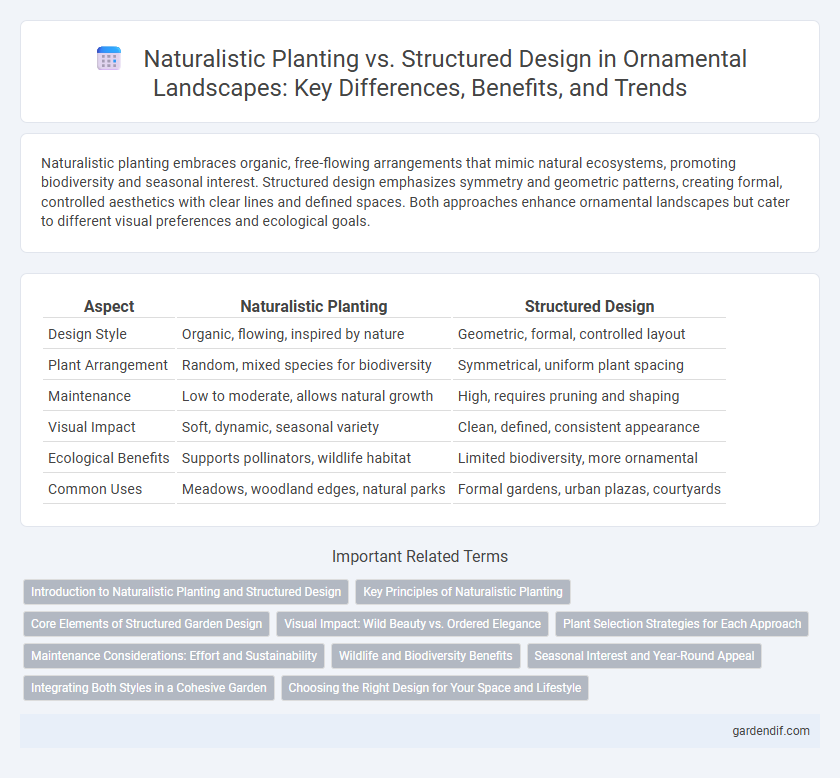
Naturalistic Planting vs Structured Design Illustration
Naturalistic planting embraces organic, free-flowing arrangements that mimic natural ecosystems, promoting biodiversity and seasonal interest. Structured design emphasizes symmetry and geometric patterns, creating formal, controlled aesthetics with clear lines and defined spaces. Both approaches enhance ornamental landscapes but cater to different visual preferences and ecological goals.
Table of Comparison
| Aspect | Naturalistic Planting | Structured Design |
|---|---|---|
| Design Style | Organic, flowing, inspired by nature | Geometric, formal, controlled layout |
| Plant Arrangement | Random, mixed species for biodiversity | Symmetrical, uniform plant spacing |
| Maintenance | Low to moderate, allows natural growth | High, requires pruning and shaping |
| Visual Impact | Soft, dynamic, seasonal variety | Clean, defined, consistent appearance |
| Ecological Benefits | Supports pollinators, wildlife habitat | Limited biodiversity, more ornamental |
| Common Uses | Meadows, woodland edges, natural parks | Formal gardens, urban plazas, courtyards |
Introduction to Naturalistic Planting and Structured Design
Naturalistic planting emphasizes ecological harmony by using native species and mimicking natural plant communities to create sustainable, low-maintenance landscapes. Structured design prioritizes geometric shapes, symmetry, and defined boundaries to establish formal aesthetics and clear visual order. Both approaches influence garden composition, plant selection, and maintenance strategies to achieve distinct ornamental effects.
Key Principles of Naturalistic Planting
Naturalistic planting emphasizes ecological harmony, using native species and diverse plant communities that mimic natural habitats. It promotes seasonal variation, dynamic growth patterns, and minimal intervention to enhance biodiversity and resilience. Key principles include a focus on plant health, soil vitality, and sustainable aesthetics aligned with local ecosystems.
Core Elements of Structured Garden Design
Structured garden design emphasizes clear lines, symmetry, and defined spaces using core elements such as geometric shapes, formal hedges, and focal points like statues or water features. Paths and borders are precisely laid out to create order and balance, often incorporating repetitive patterns and structured plant groupings to enhance visual harmony. This approach contrasts with naturalistic planting, prioritizing controlled aesthetics and intentional spatial organization to achieve a polished, cohesive ornamental garden.
Visual Impact: Wild Beauty vs. Ordered Elegance
Naturalistic planting offers a dynamic visual impact through its wild beauty, mimicking natural ecosystems with diverse, flowing plant arrangements that change with seasons. Structured design emphasizes ordered elegance, featuring symmetrical layouts and precisely pruned plants for a clean, formal appearance. Combining these approaches can balance vibrant, untamed aesthetics with refined, architectural formality in ornamental gardens.
Plant Selection Strategies for Each Approach
Naturalistic planting emphasizes native species and biodiversity, selecting plants that thrive in local ecosystems and promote wildlife habitat. Structured design prioritizes uniformity and order, using repetitive plantings of selected species with consistent shapes, colors, and bloom cycles to achieve symmetry and balance. Both strategies require understanding of plant growth habits and environmental needs to ensure sustainable and visually appealing landscapes.
Maintenance Considerations: Effort and Sustainability
Naturalistic planting requires less frequent maintenance due to its self-sustaining ecosystem that supports biodiversity, reducing the need for chemical inputs and irrigation. Structured design demands regular pruning, weeding, and fertilization to maintain precise shapes and order, increasing labor and resource consumption. Sustainable garden management favors naturalistic approaches for long-term ecological balance and cost-effective upkeep.
Wildlife and Biodiversity Benefits
Naturalistic planting enhances wildlife habitat by mimicking native ecosystems, supporting a diverse range of pollinators, birds, and insects critical for maintaining ecological balance. Structured design often prioritizes aesthetic order but may limit plant diversity and reduce habitat complexity, thereby offering fewer benefits for biodiversity. Integrating native species and varied plant layers in landscaping promotes resilient ecosystems and sustains local wildlife populations.
Seasonal Interest and Year-Round Appeal
Naturalistic planting emphasizes seasonal interest by incorporating native plants that bloom and change colors throughout the year, creating dynamic and evolving landscapes. Structured design offers year-round appeal through carefully planned evergreen elements and defined shapes that maintain visual order even in off-seasons. Balancing both approaches enhances garden aesthetics, ensuring vibrant seasonal displays alongside consistent structural integrity.
Integrating Both Styles in a Cohesive Garden
Integrating naturalistic planting with structured design creates a visually dynamic garden that balances organic growth and geometric order. Strategic placement of free-form perennials alongside defined hedges and pathways enhances biodiversity while maintaining clear spatial organization. Combining these styles leverages the ecological benefits of native plants with the aesthetic appeal of formal garden elements for year-round interest.
Choosing the Right Design for Your Space and Lifestyle
Naturalistic planting emphasizes ecological harmony with native species and organic forms, creating a relaxed, wildlife-friendly environment suited for low-maintenance spaces. Structured design features geometric shapes, symmetry, and defined borders, ideal for formal gardens or urban settings requiring order and precision. Selecting the right design depends on your space's size, maintenance capacity, and desired aesthetic, balancing natural beauty with functional needs.
Naturalistic Planting vs Structured Design Infographic

 gardendif.com
gardendif.com